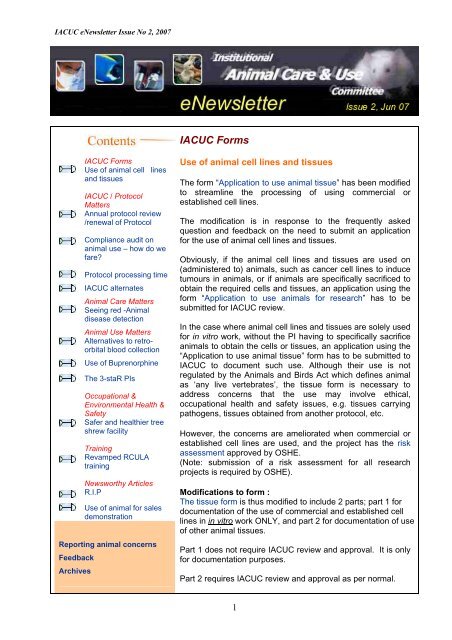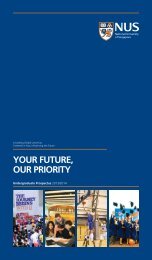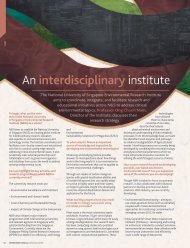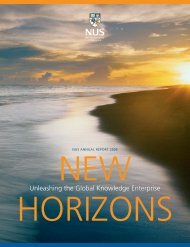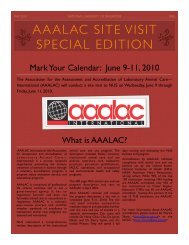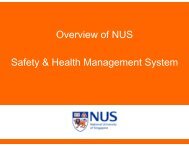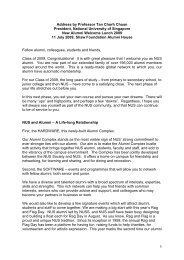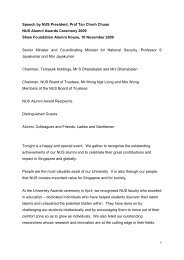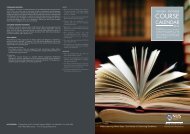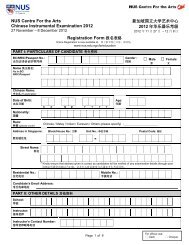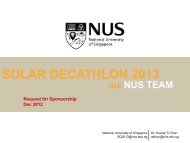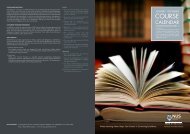IACUC Forms
IACUC Forms
IACUC Forms
Create successful ePaper yourself
Turn your PDF publications into a flip-book with our unique Google optimized e-Paper software.
<strong>IACUC</strong> eNewsletter Issue No 2, 2007<br />
<strong>IACUC</strong> <strong>Forms</strong><br />
Use of animal cell lines<br />
and tissues<br />
<strong>IACUC</strong> / Protocol<br />
Matters<br />
Annual protocol review<br />
/renewal of Protocol<br />
Compliance audit on<br />
animal use – how do we<br />
fare?<br />
Protocol processing time<br />
<strong>IACUC</strong> alternates<br />
Animal Care Matters<br />
Seeing red -Animal<br />
disease detection<br />
Animal Use Matters<br />
Alternatives to retroorbital<br />
blood collection<br />
Use of Buprenorphine<br />
The 3-staR PIs<br />
Occupational &<br />
Environmental Health &<br />
Safety<br />
Safer and healthier tree<br />
shrew facility<br />
Training<br />
Revamped RCULA<br />
training<br />
Newsworthy Articles<br />
R.I.P<br />
Use of animal for sales<br />
demonstration<br />
Reporting animal concerns<br />
Feedback<br />
Archives<br />
<strong>IACUC</strong> <strong>Forms</strong><br />
Use of animal cell lines and tissues<br />
The form “Application to use animal tissue” has been modified<br />
to streamline the processing of using commercial or<br />
established cell lines.<br />
The modification is in response to the frequently asked<br />
question and feedback on the need to submit an application<br />
for the use of animal cell lines and tissues.<br />
Obviously, if the animal cell lines and tissues are used on<br />
(administered to) animals, such as cancer cell lines to induce<br />
tumours in animals, or if animals are specifically sacrificed to<br />
obtain the required cells and tissues, an application using the<br />
form “Application to use animals for research” has to be<br />
submitted for <strong>IACUC</strong> review.<br />
In the case where animal cell lines and tissues are solely used<br />
for in vitro work, without the PI having to specifically sacrifice<br />
animals to obtain the cells or tissues, an application using the<br />
“Application to use animal tissue” form has to be submitted to<br />
<strong>IACUC</strong> to document such use. Although their use is not<br />
regulated by the Animals and Birds Act which defines animal<br />
as ‘any live vertebrates’, the tissue form is necessary to<br />
address concerns that the use may involve ethical,<br />
occupational health and safety issues, e.g. tissues carrying<br />
pathogens, tissues obtained from another protocol, etc.<br />
However, the concerns are ameliorated when commercial or<br />
established cell lines are used, and the project has the risk<br />
assessment approved by OSHE.<br />
(Note: submission of a risk assessment for all research<br />
projects is required by OSHE).<br />
Modifications to form :<br />
The tissue form is thus modified to include 2 parts; part 1 for<br />
documentation of the use of commercial and established cell<br />
lines in in vitro work ONLY, and part 2 for documentation of use<br />
of other animal tissues.<br />
Part 1 does not require <strong>IACUC</strong> review and approval. It is only<br />
for documentation purposes.<br />
Part 2 requires <strong>IACUC</strong> review and approval as per normal.<br />
1
<strong>IACUC</strong> eNewsletter Issue No 2, 2007<br />
What to do:<br />
For the use of commercial or established animal cell lines in in vitro work ONLY :<br />
Complete General Information and Part 1 of the tissue form for documentation if you are<br />
using<br />
1. Commercial Cell lines purchased from well established dealers/vendors (e.g.<br />
ATCC).<br />
2. Established cell lines supplied by collaborators from AAALAC accredited<br />
laboratories or other well established research institutes / laboratories.<br />
Correspondence (email) indicating the agreement of your collaborator to<br />
provide the cell lines should be submitted as supporting document<br />
For the use of other animal tissues<br />
Complete General Information and Part 2 of the tissue form for IAICUC review and approval if<br />
you are using primary cells, tissues, blood, fluids and cadavers.<br />
Back to Contents<br />
<strong>IACUC</strong> / Protocol Matters<br />
Annual protocol review / renewal of protocol<br />
By Dr Balaraman Deivakumar, <strong>IACUC</strong> office<br />
After granting an approval, the <strong>IACUC</strong> is required under the law to “conduct continual reviews<br />
of activities involving the use of any animal for scientific purpose, including any approved<br />
project of long duration and any long-term continual use of any individual animal for such<br />
purpose, at appropriate intervals but at least once a year”.<br />
This explains the reminders for an annual review submission to principal investigators (PIs) a<br />
month before the anniversary of the protocol approval date.<br />
In fact, depending on how the Federal and State regulations are interpreted, many <strong>IACUC</strong>s in<br />
the US require PIs to submit an Annual Protocol Review for protocol renewal before they can<br />
continue to use the animals.<br />
If we adopt such a practice, about half of the projects due for annual reviews each month<br />
would have been suspended temporarily. Why is this?<br />
One month before the due date (i.e., 1 st , 2 nd or 3 rd year of protocol approval), a first reminder<br />
to submit the Annual Protocol Review (APR) form will be sent to the PI. Reminders will be<br />
sent monthly until the APR form is received. The following are the average percentages of<br />
ARP submission after each reminder:<br />
1 st reminder – 56%<br />
2 nd reminder - 24%<br />
3 rd reminder - 14%<br />
Final reminder - 6%<br />
2
<strong>IACUC</strong> eNewsletter Issue No 2, 2007<br />
The statistics indicate that 44% of the protocols were not ‘renewed’ on time and animal work<br />
should have been suspended. It may be further interpreted that 44% of the PIs are not taking<br />
the annual review of protocol seriously. This assumption is supported by the following common<br />
discrepancies / inaccuracies in the information provided in the ARP form.<br />
Information provided by PI in the<br />
APF form<br />
Records from <strong>IACUC</strong> office<br />
1. no change in the protocol amendments were made to the<br />
approved protocol.<br />
2. yet to start the animal work; no<br />
animal work or no in vivo work was<br />
done in the past year<br />
3<br />
animals have been purchased from<br />
CARE .<br />
3. project already completed final report not submitted (soon after<br />
completion) until <strong>IACUC</strong> office sends<br />
reminder of annual review.<br />
4. protocol does not involve breeding<br />
of animals<br />
5 APR of an expired protocol<br />
submitted<br />
protocol involves breeding of animals<br />
no amendment submitted for extension<br />
of the project.<br />
<strong>IACUC</strong> seeks PIs’ understanding and co-operation in this matter. If issues of non-cooperation<br />
and non-compliance continue, <strong>IACUC</strong> would have to impose work suspension.<br />
We would like PIs to note the following:<br />
1. The 1 st reminder will now be sent 2 months ahead of the due date.<br />
2. Under the NACLAR Guidelines on Responsibilities of Investigators (chapter 8), a copy<br />
of which is included in the course materials in RCULA training, “investigator must inform<br />
the <strong>IACUC</strong> in writing when each Project is completed or discontinued; and the outcome<br />
of the Project”.<br />
APR forms can be used as a final report to <strong>IACUC</strong>, but it has to be submitted soon after the<br />
project is completed or discontinued.<br />
Back to Contents
<strong>IACUC</strong> eNewsletter Issue No 2, 2007<br />
Compliance audit on animal use –how did we fare?<br />
By Dr Mark Vinson Vallarta, <strong>IACUC</strong> office<br />
The <strong>IACUC</strong> audit team began unannounced visits to the laboratories in Feb 07. Generally,<br />
<strong>IACUC</strong> is satisfied with the outcome of the audits so far but non-compliance issues were<br />
detected in some.<br />
2006 Compliance Audit Statistics<br />
Total number of compliance audits conducted 10<br />
Total number of protocols audited 47<br />
Total number of laboratories (of 11 departments) visited 16<br />
Some deficiencies/deviations (from the approved protocols) detected :<br />
1. Unavailability and/or inaccuracy of records of the following:<br />
• breeding<br />
• daily health monitoring<br />
• post operative monitoring<br />
2. Inappropriate method of euthanasia<br />
3. Lack of proficiency in handling animals<br />
4. Discrepancies in the protocol (which necessitates the submission of an amendment<br />
application to <strong>IACUC</strong>)<br />
5. Undeclared housing location<br />
6. Personnel at work who were not listed in approved protocol<br />
7. Change in endpoints<br />
8. Inappropriate or inadequate personal protective equipment<br />
9. Inadequate animal care and post-operative care; infrequent monitoring<br />
10. Inappropriate methods used in the transportation of animals<br />
11. Inadequate housekeeping<br />
12. Inappropriate method of animal identification<br />
13. Continued use of expired drugs<br />
14. Humane endpoints – personnel do not know when early euthanasia should be performed<br />
for animals experiencing unrelieved pain and distress.<br />
15. Copies of the approved protocol are not available<br />
16. Completion of project un-reported<br />
4
<strong>IACUC</strong> eNewsletter Issue No 2, 2007<br />
<strong>IACUC</strong> would like to remind PIs of the seriousness of non-compliance in animal protocols. It<br />
may result in project suspension and closure of the laboratory. In fact, two PIs had been<br />
censured for serious non-compliance or persistence in non-compliance. They have<br />
subsequently rectified the situation.<br />
To minimise inadvertent non-compliance issues, <strong>IACUC</strong> would like to advise that team<br />
members should be familiar with the approved protocol and copies should be made available<br />
and accessible to facilitate reference.<br />
Back to Contents<br />
Protocol processing time<br />
We are pleased to advise that <strong>IACUC</strong> office has managed to maintain the processing time of<br />
approved protocols to an average of 4 to 6 weeks.<br />
We will continue to ensure that this continues to be on track.<br />
<strong>IACUC</strong> alternates<br />
To address the problem of a meeting quorum, <strong>IACUC</strong> has at its meeting on 3 Oct 06,<br />
proposed alternates for members in case they are unable to attend a scheduled monthly<br />
meeting.<br />
The introduction of alternate members has enabled us to meet quorum and hold meetings as<br />
scheduled, thereby avoiding delays in approving animal protocols due to cancellation of nonquorate<br />
meetings.<br />
Back to Contents<br />
5
<strong>IACUC</strong> eNewsletter Issue No 2, 2007<br />
Animal Care Matters<br />
Seeing red – Animal disease detection<br />
(Source: Dr Leslie Retnam, LAC)<br />
Sentinel animals in LAC’s housing facilities are regularly sent for serology multiplex tests for<br />
the presence of a number of pathogens. When the sentinel serology indicates animals are<br />
positive for any of the pathogens, at least one animal from each cage of the positive racks in<br />
the affected animal rooms will be tested by LAC for follow-up serology. Principal investigators<br />
(PIs) will be notified of the follow-up serology results when they become available.<br />
In the case where follow-up serology results are positive, you (users of the animal facilities)<br />
should be aware of the following:<br />
1. The rooms are now considered “dirty” and will be marked with a red health status sheet on<br />
the door. The positive rack(s) will also be marked. Work must be conducted by working from<br />
"clean" to "dirty" animals. When working in the "dirty" rooms, animals on the positive rack must<br />
be handled last.<br />
2. Animals in the positive cages identified on follow-up serology may be euthanized within the<br />
animal facility. These animals are not to be moved out of their rooms.<br />
3. You should contact the Lab Officers of the facilities before euthanizing any animals<br />
housed on positive racks in the rooms. LAC will euthanize these animals for you at no charge.<br />
4. If you have animals in the affected room(s) which are immuno-compromised, you should<br />
contact the LAC veterinarian (Dr Leslie Retnam via ahurl@nus.edu.sg or tel ext 3051)<br />
immediately.<br />
5. If you have moved ANY animals from these rooms into another room, onto another rack, to<br />
another investigator, and/or facility, you should immediately contact the LAC veterinarian (Dr<br />
Leslie Retnam’s contact details earlier given) as these animals pose a possible health threat<br />
to the animals of other investigators within the facility. Moved animals must be tested.<br />
6. Individuals with dirty or suspect (yellow) rooms are expected to restrict animal-related<br />
activities to their animal room, as use of shared procedure rooms can advance pathogen<br />
spread within the facility.<br />
7. Special or additional measures and precautions may be required when accessing the<br />
affected rooms. The protective mechanism will differ depending on the disease and the mode<br />
of transmission. For instance, if the affected rooms are positive for Tyzzer's, GDVII and Parvo,<br />
the precautions are :<br />
• When entering a ‘dirty’ room, individuals must don an additional pair of gloves over<br />
their regular barrier apparel.<br />
• When leaving the ‘dirty’ room, individuals must remove the additional gloves and<br />
dispose of them as they leaving the ‘dirty’ room, in the ‘dirty’ room. Do not wear these<br />
gloves into the hallway, as they may be contaminated.<br />
You should consult the LAC veterinarian on the special or additional measures and<br />
precautions to be taken when your rooms are affected.<br />
Back to Contents<br />
6
<strong>IACUC</strong> eNewsletter Issue No 2, 2007<br />
Animal Use Matters<br />
Alternatives to retro-orbital blood collection<br />
(Source: Dr Leslie Retnam, LAC)<br />
We continue to receive protocols describing retro-orbital route as the method of routine/serial<br />
blood sample collection. It is a technique that can have severe consequences for the animals<br />
and, therefore, the <strong>IACUC</strong> does not recommend retro-orbital bleeding for non-terminal<br />
procedures, other than exceptional and justifiable circumstances, under which the procedure<br />
must be performed with anaesthesia and by competent persons and, repeated sampling from<br />
the same site (same side of the eye) should not be performed at intervals shorter than 4 weeks.<br />
It is, however, acceptable as a terminal procedure under anaesthesia.<br />
Retro-orbital method can easily be replaced by the following techniques:<br />
1. Facial vein (limited to adult mice):<br />
This is a relatively new technique and repeated sampling is possible by using alternate sides of<br />
the face in the area of the mandible. The sample may be a mixture of venous and arterial<br />
blood. The method is said to require less training than tail, retro-orbital sampling to reliably<br />
withdraw a reasonable quantity of blood. It may be performed on conscious animals that are<br />
properly restrained to allow proper site alignment and venous compression for good blood flow<br />
(see Figure below). A minimal amount of equipment is required and can be performed<br />
relatively rapidly. 20G or smaller size needles should be used to prevent excessive bleeding.<br />
More information on this technique may be found at the web site:<br />
http://www.ahc.umn.edu/rar/facial_vein.html<br />
For video clips, see the following commercial video at Medipoint:<br />
(Windows Media) http://www.medipoint.com/html/directions_for_use1.html<br />
(Quicktime) http://www.medipoint.com/html/directions_for_use2.html<br />
7
<strong>IACUC</strong> eNewsletter Issue No 2, 2007<br />
2. Saphenous vein:<br />
A technique for obtaining blood from the saphenous vein of mice and other small animals has<br />
been described and is rapidly becoming the technique of choice for many investigators.<br />
This procedure does not require that the mouse be anesthetized to collect a blood sample,<br />
and is much less invasive than retro-orbital method. A tube can be used to restrain the<br />
mouse, and the hind leg is extended by applying gentle downward pressure just above the<br />
knee. The hair over the tarsal area is shaved with clippers followed by a number 11 scalpel<br />
blade, and the vein is pricked with a needle (25 gauge is usually adequate). Blood can be<br />
collected in a microcapillary tube.<br />
Smearing a small amount of silicone grease over the area to be punctured helps to prevent<br />
the blood from coming into contact with the skin and minimizes blood clotting.<br />
When the blood has been collected, gentle pressure applied with a piece of gauze should be<br />
used to effect hemostasis. Pictures demonstrating this technique may be found at the web<br />
site: http://www.uib.no/vivariet/mou_blood/Blood_coll_mice_.html<br />
Back to Contents<br />
An update on the use of Buprenorphine<br />
(Source: from the “Vet Regulatory News” June 2007).<br />
In Aug 06, AVA received notification from MOH that Buprenorphine or B has been classified<br />
as a Class A Controlled Drug under the First Schedule of the Misuse of Drugs Act w.e.f. 14<br />
Aug 06. The sole supplier, Schering-Plough can no longer import B which effectively bans the<br />
use of B for vet use.<br />
MOH received an appeal from a vet for MOH to allow the use of B as an analgesic for<br />
veterinary practice. On 16 Mar 07, AVA sought feedback from practicing vets on MOH’s<br />
position and requested vets to indicate if they are required to use B in their course of work.<br />
AVA has sent the consolidated feedback and appeal for MOH to re-consider permitting vets to<br />
use B as an effective analgesia for alleviation of pain in animals.<br />
In May 2007, MOH replied to indicate that AVA should discuss the matter with the Central<br />
Narcotics Bureau (CNB) as the use of B falls under the Misuse of Drugs Act.<br />
The AVA is currently in talks with CNB and would update the veterinary community<br />
accordingly.<br />
Back to Contents<br />
8
<strong>IACUC</strong> eNewsletter Issue No 2, 2007<br />
The 3-staR PIs<br />
By Dr Balaraman Deivakumar, <strong>IACUC</strong> office<br />
It is gratifying that some researchers are taking the 3Rs principles of animal care and use<br />
seriously. They have Replaced animals, Reduced animal numbers or Refined procedures to<br />
animals, during the course of their project.<br />
The <strong>IACUC</strong> is pleased to list these researchers below in appreciation of their efforts :<br />
Name of the PI/<br />
Department<br />
Prof Ariff Bongso<br />
O & G<br />
Dr Steve Cheung Nam Sang<br />
Biochemistry<br />
Prof Chou Loke Ming<br />
DBS<br />
Dr Davide Lomanto<br />
Surgery<br />
Prof Ding Jeak Ling<br />
DBS<br />
A/P Feng Si-Shen<br />
ChBE<br />
Dr Gan Yunn Hwen<br />
Biochemistry<br />
A/P Go Mei Lin<br />
Pharmacy<br />
Prof Barry Halliwell<br />
Biochemistry<br />
A/P M Prakash Hande<br />
Physiology<br />
Prof R Manjunatha Kini<br />
DBS<br />
Dr Koh Hwee Ling<br />
Pharmacy<br />
Prof Li Fong Yau Sam<br />
Chemistry<br />
A/P Eugene K W Sim<br />
Surgery<br />
A/P Wilder-Smith E P<br />
Medicine<br />
Dr Zhu Yi-Zhun<br />
Pharmacology<br />
Back to Contents<br />
Replacement / Reduction / Refinement<br />
Refinement: Use of finer gauge hypodermic needles for administration of<br />
substances.<br />
Refinement: Euthanasia by CO2 instead of cervical dislocation.<br />
Reduction: Animal sampling indicated small size animals were not<br />
suitable. The experimental group for small size animals was eliminated.<br />
Replacement: Live animals were replaced with virtual surgical simulators.<br />
Multiple procedures performed on deeply anaesthetized animal before<br />
euthanasia, and tissue sharing with other researchers/specialists.<br />
Replacement: Use of cell lines instead of live animals to test bioactive<br />
peptides.<br />
Refinement: Improved injection rate of infusion.<br />
Refinement: Instead of infecting the animals, macrophages are isolated<br />
and infected; thereby eliminating potential pain and distress due to<br />
infection.<br />
Replacement: Use of cell lines instead of live animals to evaluate the<br />
neuroprotective effects of synthesized compounds on cells challenged<br />
with the neurotoxic agent.<br />
Reduction: Reduce the number of doses in experiment.<br />
Replacement: Collect mouse fibroblasts from others (tissue sharing)<br />
instead of procuring animals.<br />
Refinement: Euthanasia by CO2 instead of cervical dislocation.<br />
Refinement: Purchased rabbit blood from LAC, hence minimizing pain<br />
and distress to the animals and allowing more experiments to be carried<br />
out.<br />
Reduction: Reduced number of animals using laser induced fluorescence<br />
system.<br />
Reduction: Conduct pilot study to establish group sample size.<br />
Refinement: Refined procedure to reduce number of tests.<br />
Refinement: Rats are kept warm in between the water maze tests.<br />
9
<strong>IACUC</strong> eNewsletter Issue No 2, 2007<br />
Occupational & Environmental Health & Safety<br />
Making the tree shrew facility a safe and healthier place (for personnel and<br />
animals)<br />
By Mr G Saravanan, OSHE.<br />
A room at AHU has been renovated for animal work involving tree shrews. OSHE conducted a<br />
walkthrough inspection before it was commissioned, and the following changes were made by<br />
AHU staff to ensure a healthy work environment. .<br />
Improved ventilation<br />
The fans (Fig.1) were configured to give a negative pressure potential in the room, as with any<br />
other BSL-2 facility.<br />
Mosquito netting was also installed to prevent mosquito vectors from entering and spreading<br />
any potential pathogens that may be present in the animals.<br />
Anteroom for changing<br />
Figure 1. Fans with mosquito nets<br />
The initial design did not have an area demarcated for changing into the appropriate PPE for<br />
animal work. An anteroom outside the main lab was designated as a changing area. This<br />
provides the demarcation of clean and dirty areas. A fire extinguisher (Fig. 2) was also installed<br />
in this area.<br />
Figure 2. Anteroom<br />
10
<strong>IACUC</strong> eNewsletter Issue No 2, 2007<br />
An acrylic sheet (Fig. 3) placed outside the main door was intended to deflect rain. This had<br />
sharp edges and posed a physical hazard to anyone entering the room. Because of this, the<br />
sharp edges were sanded away.<br />
Figure 3. Acrylic sheet at entrance<br />
Lighting (Fig.4) was improved in the lab through the use of twin fluorescent tubes, alleviating<br />
eye strain and fatigue resulting from long hours in the facility.<br />
Figure 4. Fluorescent lighting in lab<br />
These improvements will aid in upholding safety & health standards in NUS.<br />
What is a tree shrew? Check it out in Americazoo.com<br />
Back to Contents<br />
11
<strong>IACUC</strong> eNewsletter Issue No 2, 2007<br />
Training<br />
Revamped RCULA training<br />
(Source: LAC)<br />
The RCULA course has been revamped to address participants’ specific training needs and<br />
for their convenience.<br />
1. Participants can choose to be trained in the species of interest.<br />
2. Re-training of participants from NUS is free of charge.<br />
3. Training will be conducted monthly, on the 3 rd Thursday of the month.<br />
D A Y O N E<br />
General Lecture Programme<br />
9.00 am to 12.15 pm @ CELS Auditorium<br />
9:00 am<br />
Registration and Introduction<br />
9:30 am The <strong>IACUC</strong> - Responsibilities, Functions and Guidelines<br />
on completing the <strong>IACUC</strong> application forms<br />
10:00 am Biomedical Research Regulations, NACLAR Guidelines and<br />
You<br />
10:30 am Q and A<br />
10:45 am Coffee Break<br />
11:15 am The 3R’s, Ethical Responsibilities of a Researcher and the Use<br />
of Alternatives<br />
11:45 am Occupational Health and Safety in Biomedical Research<br />
12:15 pm Q and A<br />
Rats / Mice : Species specific training including lectures which apply<br />
2.00 pm to 6.00 pm @ AHU<br />
Species specific training on Rats, on Mice, and on Aseptic Surgery<br />
Includes lectures (specific to rats and mice) with information:<br />
(i) Anaesthesia, Analgesia, Recognising Pain,<br />
(ii) Animal Handling & Blood Collection<br />
(iii) Intro to Surgery, Post-op Care and Euthanasia and<br />
(iv) Animal Disease and Diagnosis and Hands-on practical<br />
(existing format using video)<br />
12
<strong>IACUC</strong> eNewsletter Issue No 2, 2007<br />
D A Y T W O<br />
Rabbits / GPigs & Pigs : Species specific training including lectures which apply<br />
9.00am to 1.00 pm @ AHU<br />
Species specific training on Rabbits and on Guinea pigs (lectures and hands-on)<br />
2.00 pm to 6.00 pm @ AHU<br />
Species specific training on Pigs (lectures only).<br />
HOW IT WORKS<br />
Participants will be trained in individual species.<br />
If a participant would like training in multiple species, eg, mice, rats and rabbits, he/she would<br />
need to be present for Day One morning lectures, Day One afternoon for hands-on (for rats<br />
and mice) and then attend Day Two morning (for rabbits).<br />
COSTS<br />
For NUS staff and students:<br />
Lectures $50<br />
Each species specific session $50 (includes re-training sessions)<br />
For non-NUS staff and students:<br />
Lectures $80 plus GST<br />
Each species specific session $80 plus GST<br />
If a participant wanted training only in mice, he/she would pay $50 for lectures plus $50 for<br />
mice session.<br />
The charge for species specific sessions includes costs for re-training should a researcher<br />
request or require that.<br />
After attending species specific training on rats and/or mice, if researchers need to use rabbits<br />
in future, they are required to attend the next course on species specific training on rabbits. A<br />
separate charge of $50 is applicable.<br />
Back to Contents<br />
13
<strong>IACUC</strong> eNewsletter Issue No 2, 2007<br />
Newsworthy Articles<br />
1. RIP<br />
A special funeral and mourning ceremony was held on 28 April - for mice. Who did that and<br />
why? Read more.<br />
It is noted that some places in the US have similar ceremonies or ways to remember the<br />
important contributions that animals make to ensure we have longer, healthier lives.<br />
2. Use of animals for sales demonstration<br />
Early this year, a neurosurgeon at the Cleveland Clinic (ranked one of the top 3 hospitals in<br />
the US by US News and World Report 2006) caused a furore when it was reported that he<br />
induced an aneurysm (a localized widening of an artery, vein, or the heart) in an<br />
anaesthetized dog. This was a demonstration of a medical device to sales people. The<br />
animal was subsequently euthanized.<br />
A report by The Scientist on the investigation of the incident indicated that such animal use<br />
would unlikely be acceptable to an institution’s <strong>IACUC</strong>. The report has provoked many<br />
interesting comments from its readers.<br />
Back to Contents<br />
<strong>IACUC</strong> Office: c/o Department of Biological Sciences, 14 Science Drive 4, Singapore 117543.<br />
Tel: 6516 2861. Fax: 6778 6216.<br />
<strong>IACUC</strong> Website: http://www.nus.edu.sg/iacuc/index.shtml<br />
<strong>IACUC</strong> application forms Application submission deadlines<br />
<strong>IACUC</strong> meeting schedule RCULA training course<br />
14


